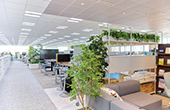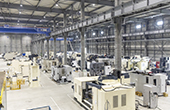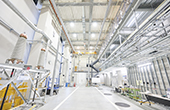Itami Works was established in 1941 as the home of Sumitomo Electric’s operations for products other than electric wire. Among the company’s facilities, only Osaka Works predates Itami Works. We were at Itami Works to tour CRystal Lab., the innovative research hub that has been up and running since 2020. We met Technology Executive Takeru Nakashima and Chief Specialist Tomoyuki Awazu of the Advanced Materials Laboratory as well as Senior Specialist Takeshi Tsuguma, of the Development Administration Department, R&D Planning & Administration Division. Firstly, Mr. Nakashima briefed us on Itami Works.
“Itami Works was set up to manufacture products other than electric wire to meet surging wartime demand. The first products made here were wire drawing dies, which are tool used in the manufacture of power line cables and low-voltage wires for motor vehicles. We have been tackling new products and expanding into new markets ever since, taking advantage of materials such as cemented carbide used for dies. Underpinned by R&D of industrial materials, Itami Works has emerged as a formidable operation devoted to the production and development of cutting tools, synthetic diamonds, compound semiconductors, and special steel wires such as steel cords.” Another product category in which Itami Works has particular prowess includes sintered parts made using powder metallurgy technology to solidify iron powder and other materials. Sumitomo Electric takes pride in all the products produced here. And CRystal Lab. includes four R&D labs dedicated to these specialized materials and products.
Mr. Awazu explains the CRystal Lab. concept. “The name expresses our determination to create a development base where knowledge circulates, wisdom is accumulated, links are forged and technology crystallizes. Everything is designed to attract talented people. We want CRystal Lab. to be where successive innovations take wing.” The upper case “CR” in “CRystal” refers to the three “CRs” that Sumitomo Electric considers crucially important for the success of R&D: Championship Record; Cost Reduction; and Connected Research and development. The concentration of the four laboratories is improving R&D efficiency as well as facilitating cross-functional initiatives.
CRystal Lab. consists of two buildings—one for R&D facilities, the other for supporting administrative functions—with 16,000 square meters of floor space. We are shown around the office building where the staff are champions of workstyle reform. Ascending to the roof, we are in for a surprise. It’s covered in lush greenery. There is also a fine view of Abeno Harukas, Japan’s tallest building, in distant downtown Osaka. The offices on the third and fourth floors embody the 2Cs concept of “concentration” and “communication.” There are solo workspaces where individuals can concentrate on their work without distraction. In contrast, the collaborative space at the center of each floor is furnished with tables and chairs of various styles. There is a high counter where people converse while standing as well as restaurant-style tables conducive to constructive informal gatherings. Benches whose seats are tatami matting are a novel riff on a traditional theme. Employee’s ideas and preferences are fully reflected in the decor. The work areas are islands, each comprising four desks, and are designed to encourage fruitful exchanges among technical staff. Having R&D and administrative support functions concentrated at a single site helps lubricate the wheels of R&D.
Now, it’s time for some fun in the showroom. Here, we can get to grips with the company’s technologies and products. There really is no substitute for hands-on experience. For example, we measured the hardness of cemented carbide, checked the bend resistance of rubber reinforced with steel cords, and, most exciting of all, used an synthetic diamonds blade to slice through ice like a knife through butter.
The layout of the R&D building is ingenious. Corridors are wide and welcoming because “It’s important to be as open as possible with clients and users so that they can understand what we are doing,” says Mr. Nakashima.
The Analysis Technology Research Center is one of the few facilities in Japan with an ultra-high-voltage transmission electron microscope for atomic-level observation. The center supports other departments’ R&D by developing advanced analysis technology. In the former building, which was 60 years old, the vibration through the floors sometimes compromised accuracy.
CRystal Lab. is promoting interdepartmental exchanges and collaboration with external organizations is already underway. Exposure to partners’ R&D approaches can be stimulating, leading to discoveries. Relishing a challenge, Mr. Nakajima says, “I want CRystal Lab. to fulfill its mission as a source of technologies and products that help resolve the environmental and energy issues confronting contemporary society.”

 EN
EN



















































